
Apple has recently secured another patent for a technology that would enable Face ID integration within the display, allowing for a more minimized camera cutout.
Although Apple has been pursuing this innovation for several years, there are a few compelling reasons to believe that this technology might finally debut with the iPhone 17 series …
Face ID Integrated into the Display
The concept of incorporating Face ID emitters and sensors beneath the display surface has appeared in several Apple patents, including one from 2021:
As previously mentioned, an electronic device can utilize through-display imaging for various imaging, sensing, data collection, or light capture activities, including, but not limited to […] facial recognition.
There were predictions regarding its integration into the iPhone 15, and again for the iPhone 16 – neither of which materialized, of course.
Recently, Apple obtained another patent outlining a method for this (discovered by Patently Apple).
The portable device further includes an optical radiation source that could be used for purposes such as, for instance, 3D mapping or facial recognition. This invention enables the positioning of the source behind an active display area, as illustrated by a dotted-line frame. Such placement conserves display space, as the source would otherwise require a notch area (typically utilized for other devices, such as cameras).
Two Indications for the iPhone 17
I acknowledge the irony in suggesting that it might feature in the iPhone 17 after previously predicting its emergence in the last two generations! However, there are a couple of reasons to consider that this time might be different.
First, there have been numerous reports that at least one model in this year’s lineup will showcase a smaller display cutout. Jeff Pu indicated that the iPhone 17 Pro Max would have a “significantly narrowed Dynamic Island.” Integrating Face ID beneath the display would be the most straightforward method to achieve this.
Second, there’s the iPhone 17 Air. Apple’s aim here is to create an ultra-sleek design, and minimizing the Dynamic Island to a camera punch-hole would perfectly align with this objective.
Add to this the fact that the Air version is reportedly priced higher than the Pro Max, despite featuring only a single camera and lacking the specifications of the Pro models. Would a slimmer design truly justify such a price increase? Or would it require supplementary premium design features, like … a punch-hole display?
Could 2025 finally be the year that we see this come to fruition, either in the iPhone 17 Pro Max, iPhone 17 Air, or perhaps both? We welcome your thoughts in the comments.
Image: StrongChimp Bower/DMN
: We utilize income-earning auto affiliate links. More.



